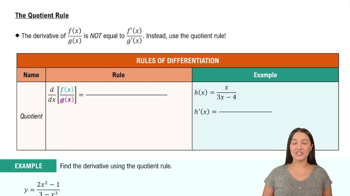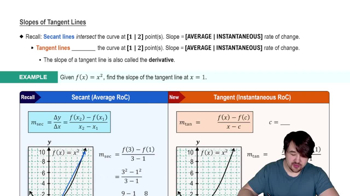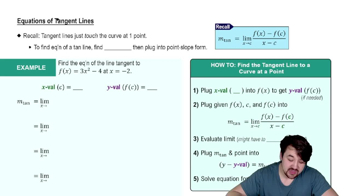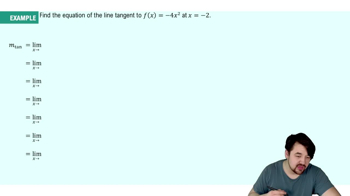Table of contents
- 0. Functions7h 52m
- Introduction to Functions16m
- Piecewise Functions10m
- Properties of Functions9m
- Common Functions1h 8m
- Transformations5m
- Combining Functions27m
- Exponent rules32m
- Exponential Functions28m
- Logarithmic Functions24m
- Properties of Logarithms34m
- Exponential & Logarithmic Equations35m
- Introduction to Trigonometric Functions38m
- Graphs of Trigonometric Functions44m
- Trigonometric Identities47m
- Inverse Trigonometric Functions48m
- 1. Limits and Continuity2h 2m
- 2. Intro to Derivatives1h 33m
- 3. Techniques of Differentiation3h 18m
- 4. Applications of Derivatives2h 38m
- 5. Graphical Applications of Derivatives6h 2m
- 6. Derivatives of Inverse, Exponential, & Logarithmic Functions2h 37m
- 7. Antiderivatives & Indefinite Integrals1h 26m
- 8. Definite Integrals4h 44m
- 9. Graphical Applications of Integrals2h 27m
- 10. Physics Applications of Integrals 2h 22m
2. Intro to Derivatives
Tangent Lines and Derivatives
Problem 3.2.25a
Textbook Question
21–30. Derivatives
a. Use limits to find the derivative function f' for the following functions f.
f(x) = 1/x+1; a = -1/2;5
 Verified step by step guidance
Verified step by step guidance1
Step 1: Understand the problem. We need to find the derivative of the function f(x) = \frac{1}{x+1} using the definition of the derivative, which involves limits.
Step 2: Recall the definition of the derivative. The derivative f'(x) of a function f(x) at a point x is given by the limit: f'(x) = \lim_{h \to 0} \frac{f(x+h) - f(x)}{h}.
Step 3: Substitute f(x) = \frac{1}{x+1} into the definition. This gives us: f'(x) = \lim_{h \to 0} \frac{\frac{1}{x+h+1} - \frac{1}{x+1}}{h}.
Step 4: Simplify the expression inside the limit. Find a common denominator for the fractions in the numerator: \frac{1}{x+h+1} - \frac{1}{x+1} = \frac{(x+1) - (x+h+1)}{(x+h+1)(x+1)} = \frac{-h}{(x+h+1)(x+1)}.
Step 5: Substitute the simplified expression back into the limit and simplify further: f'(x) = \lim_{h \to 0} \frac{-h}{h(x+h+1)(x+1)}. Cancel the h in the numerator and denominator, then evaluate the limit as h approaches 0.
 Verified video answer for a similar problem:
Verified video answer for a similar problem:This video solution was recommended by our tutors as helpful for the problem above
Video duration:
8mPlay a video:
Was this helpful?
Key Concepts
Here are the essential concepts you must grasp in order to answer the question correctly.
Derivatives
A derivative represents the rate of change of a function with respect to its variable. It is defined as the limit of the average rate of change of the function as the interval approaches zero. In calculus, the derivative is often denoted as f'(x) and can be interpreted as the slope of the tangent line to the graph of the function at a given point.
Recommended video:

Derivatives
Limits
Limits are a fundamental concept in calculus that describe the behavior of a function as its input approaches a certain value. They are essential for defining derivatives, as the derivative is calculated using the limit of the difference quotient. Understanding limits allows us to analyze functions at points where they may not be explicitly defined or where they exhibit discontinuities.
Recommended video:

One-Sided Limits
Difference Quotient
The difference quotient is a formula used to calculate the average rate of change of a function over an interval. It is expressed as (f(x+h) - f(x))/h, where h is the change in x. As h approaches zero, the difference quotient approaches the derivative of the function, providing a way to find instantaneous rates of change.
Recommended video:

The Quotient Rule

 5:13m
5:13mWatch next
Master Slopes of Tangent Lines with a bite sized video explanation from Nick
Start learningRelated Videos
Related Practice




